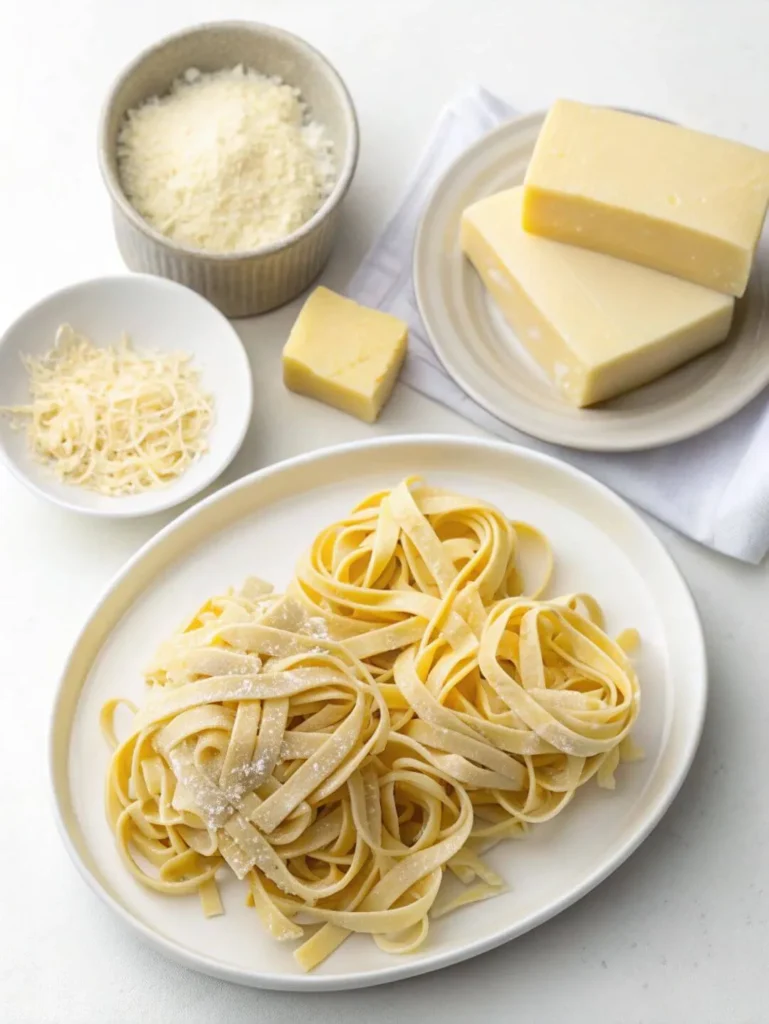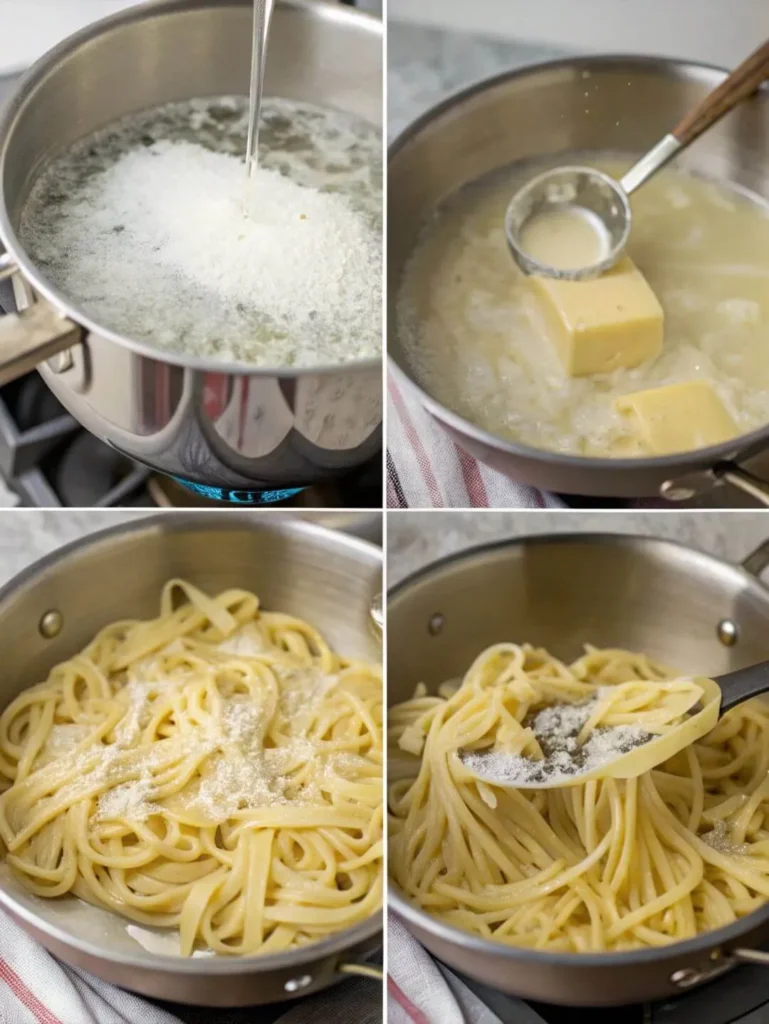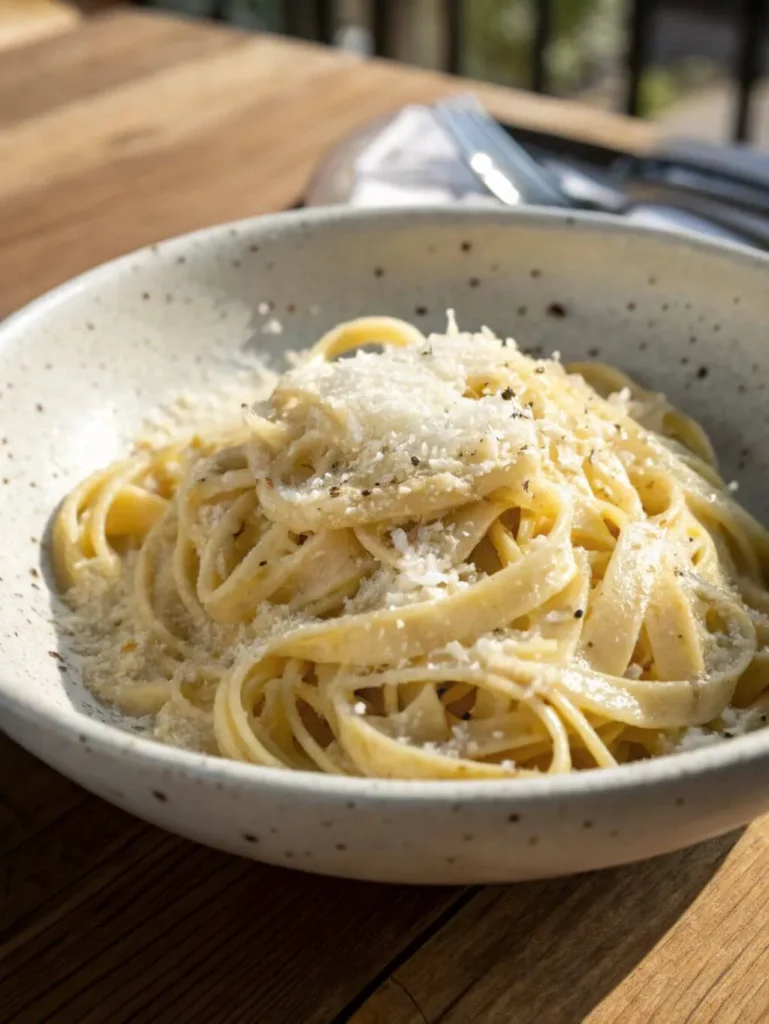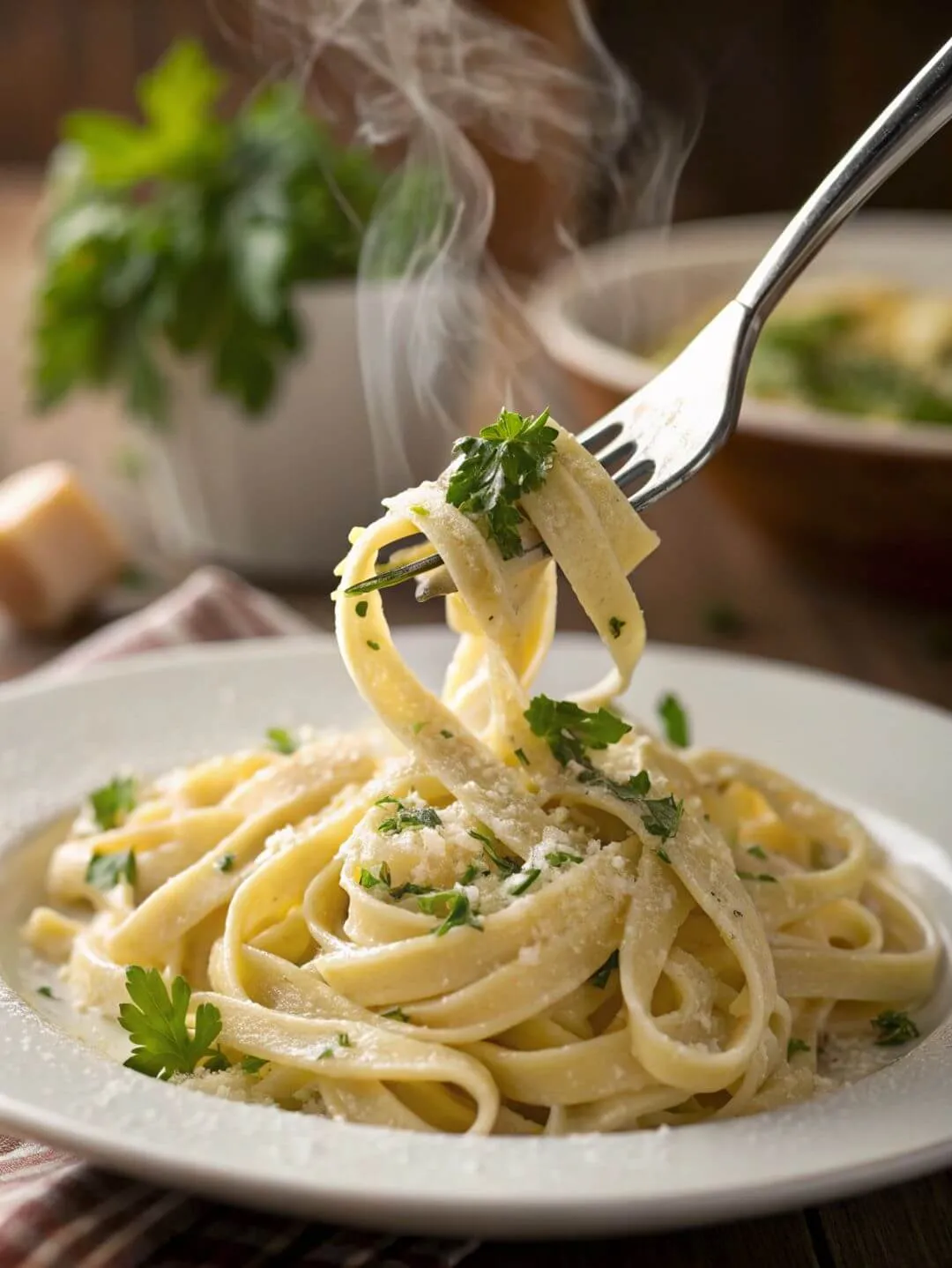Fettuccine Alfredo was one of the first pasta dishes I truly fell in love with. Just butter, Parmesan, and hot noodles—simple, rich, and comforting in all the right ways. No rules, no fancy tricks—just pure joy in every bite.
At Easy Noodle Recipes, that’s exactly what we’re about. Recipes that feel familiar, taste incredible, and bring people together.
In this guide, I’ll show you how to make Alfredo from scratch, what makes it taste better, and whether adding egg is really worth it.
Let’s get into it—the creamy way.
What Is Fettuccine Fettuccine Alfredo?
– The Humble Origins in Rome
Fettuccine Alfredo may be a restaurant staple in America today, but its story starts in a tiny kitchen in Rome over 100 years ago. The original version wasn’t loaded with cream or garlic—it was just fresh fettuccine tossed with butter and grated Parmesan, known as “fettuccine al burro.” That’s it. No cream, no fuss—just simplicity done perfectly.
Alfredo di Lelio, an Italian restaurateur, created the dish in 1914 to help his pregnant wife eat something nourishing and easy on the stomach. The rich, buttery noodles worked—and soon, it worked on his restaurant guests too.
– From Italy to America: A Creamy Evolution
When Hollywood stars visited Alfredo’s restaurant in the 1920s, they brought the recipe back to the U.S., where it quickly evolved. American versions added heavy cream, garlic, and sometimes even chicken, turning the dish into the rich, decadent Fettuccine Alfredo many of us grew up with.
While it may not be 100% traditional anymore, it’s absolutely beloved. It’s the kind of dish you can dress up or down, make in 20 minutes, and serve to anyone—from picky kids to dinner guests.
| Nutrient | Amount |
|---|---|
| Calories | 580 kcal |
| Total Fat | 39 g |
| Saturated Fat | 24 g |
| Unsaturated Fat | 13 g |
| Trans Fat | 1 g |
| Cholesterol | 115 mg |
| Sodium | 480 mg |
| Total Carbohydrates | 35 g |
| Dietary Fiber | 2 g |
| Total Sugars | 1 g |
| Protein | 18 g |
Nutrition Chart (% Daily Value*)
Calories: 580 kcal
Fat (50%):
Saturated Fat (120%):
Cholesterol (38%):
Sodium (20%):
Carbohydrates (12%):
Protein (36%):
*Estimated % Daily Values based on a 2,000 calorie diet.
Ingredients for Classic Fettuccine Alfredo
– Just Three Ingredients, Infinite Comfort

If you’ve ever wondered what makes Fettuccine Alfredo so irresistibly creamy, you might be surprised at how simple it really is. No need for a mile-long ingredient list—this dish keeps it simple. Instead, it’s built on three essentials that work together in perfect harmony.
Here’s what you need to make a truly great Fettuccine Alfredo:
- Fettuccine pasta – flat, wide noodles that hold onto sauce like a dream
- Unsalted butter – adds richness and blends seamlessly with cheese
- Freshly grated Parmesan cheese – salty, nutty, and the heart of the sauce
No cream. No shortcuts. Just honest ingredients with the right technique. When tossed with a little pasta water and heat, these simple components melt into the signature smoothness Fettuccine Alfredo is known for.
👩🍳 Olivia’s Tip: Always grate your Parmesan fresh. It melts better, tastes stronger, and turns your Alfredo into something restaurant-worthy.
– Add-Ins That Elevate the Sauce
While traditional Fettuccine Alfredo keeps it simple, many home cooks enjoy adding a few extras to suit their taste. These add-ins don’t take away from the dish—they build on its creamy base.
Try mixing in:
- Add a splash of heavy cream for extra richness and a silky finish.
- Minced garlic or garlic powder for depth
- Black pepper or red chili flakes add a subtle kick of heat.
- A pinch of nutmeg for unexpected warmth
- Use salted pasta water to balance flavors and help the sauce cling beautifully.
Whether you stick to the classic or make it your own, Fettuccine Alfredo is endlessly adaptable. That’s what makes it such a versatile comfort food.
– Choosing the Best Pasta and Cheese
Not all noodles—or cheeses—are created equal. For the best-tasting Fettuccine Alfredo, pay attention to quality.
- Egg-based fettuccine offers a tender, rich bite that holds up under sauce
- Gluten-free? Try brown rice or chickpea versions that mimic texture well
- Avoid pre-shredded cheese. Stick with Parmigiano-Reggiano or similar and grate it fresh for the silkiest results
Whether it’s your first time making Fettuccine Alfredo or your hundredth, starting with good ingredients sets you up for success.
How to Make Fettuccine Alfredo from Scratch
– Simple Steps, Big Flavor
You don’t need a culinary degree—or a packed pantry—to make an amazing bowl of Fettuccine Alfredo at home. What you do need is timing, heat, and a few smart techniques. This dish comes together in under 30 minutes, but the key is in how you bring the sauce and pasta together at just the right moment.
Here’s how to do it, the way I’ve learned through years of trial, error, and a whole lot of cheese.
Step-by-Step Instructions:

- Boil the Pasta
Bring a large pot of salted water to a boil. Add fettuccine and cook until al dente, about 8–10 minutes for dried pasta. If using fresh pasta, it may only take 2–3 minutes. - Reserve Pasta Water
Before draining, reserve about 1 cup of starchy pasta water. This will help emulsify the sauce and create that glossy, clinging texture Fettuccine Alfredo is famous for. - Melt the Butter
In a large skillet over medium-low heat, melt your unsalted butter until just bubbly—but not browned. - Toss in the Pasta
Add the hot, drained pasta directly into the skillet. Use tongs to toss and coat every strand of fettuccine in the melted butter. - Add Parmesan Gradually
Turn off the heat and sprinkle in the freshly grated Parmesan a handful at a time, tossing vigorously between each addition. The residual heat from the pasta will melt the cheese into the butter, creating a creamy coating. - Adjust with Pasta Water
Add small splashes of pasta water to thin the sauce as needed. It should be smooth, creamy, and just loose enough to cling to the noodles without pooling on the plate. - Taste and Season
Add more cheese, a pinch of black pepper, or a dash of nutmeg to taste. The saltiness from the cheese and pasta water usually means you won’t need extra salt—but taste and trust your palate.
🍽️ Olivia’s Kitchen Tip: Keep tossing! Alfredo isn’t a pour-on-top sauce—it’s built directly on the noodles. Tossing is what binds it all together.
– What You Shouldn’t Do
- Don’t use cold cheese: It won’t melt smoothly.
- Don’t use pre-grated Parmesan: It contains anti-caking agents that prevent emulsifying.
- Don’t reheat Alfredo too quickly: It can break the sauce and leave you with greasy pasta.

Fettuccine Alfredo Recipe – Creamy, Authentic & Easy to Make
- Total Time: 51 minute
- Yield: 2 servings 1x
Description
This Fettuccine Alfredo recipe is the perfect blend of creamy, cheesy, and classic. Made with just butter, Parmesan, and pasta, it’s quick, comforting, and full of authentic Italian flavor—ready in under 30 minutes.
Ingredients
200g fettuccine pasta
½ cup unsalted butter
1 cup freshly grated Parmesan
Salt, to taste
¼ cup reserved pasta water
Optional: garlic, cream, nutmeg, pepper
Instructions
Boil pasta until al dente. Reserve ¼ cup pasta water.
Melt butter in pan. Add pasta and toss.
Off heat, stir in Parmesan gradually.
Add pasta water as needed to adjust texture.
Season and serve immediately.
Notes
For extra richness, use a splash of cream. For bold flavor, finish with cracked pepper or a pinch of nutmeg.
- Prep Time: PT5M
- Cook Time: PT15M
- Category: Main Course
- Cuisine: Italian
Nutrition
- Serving Size: 2 servings
- Calories: 580 kcal per serving
- Sugar: 1 g
- Fat: 39 g
Keywords: Fettuccine Alfredo, creamy pasta, Italian noodles, Alfredo sauce
What Makes Alfredo Pasta Taste Better?
– A Classic Sauce with Endless Possibilities
While traditional Fettuccine Alfredo is delicious on its own, sometimes you’re in the mood to give it a little something extra. Maybe it needs more depth. Maybe you’re serving guests. Or maybe you just want to experiment.
The good news? Alfredo sauce is incredibly flexible. With just a few smart additions, you can elevate the entire dish—without overpowering its signature creaminess.

– Simple Add-Ins That Make a Big Impact
Here are a few of my favorite ways to boost flavor while keeping that creamy Alfredo soul intact:
- Fresh garlic (sautéed in the butter) for warmth and aroma
- A splash of white wine before adding the cheese for brightness
- Black pepper or red chili flakes for subtle heat
- A pinch of nutmeg to enhance the depth of Parmesan
- A spoonful of cream cheese for extra tang and texture
- Lemon zest or a squeeze of juice to brighten the richness
Even a touch of finely chopped parsley at the end can bring contrast to the cream. It’s all about layering flavors while respecting the base.
What Makes Alfredo Pasta Taste Better?
– A Classic Sauce with Endless Possibilities
While traditional Fettuccine Alfredo is delicious on its own, sometimes you’re in the mood to give it a little something extra. Maybe it needs more depth. Maybe you’re serving guests. Or maybe you just want to experiment.
The good news? Alfredo sauce is incredibly flexible. With just a few smart additions, you can elevate the entire dish—without overpowering its signature creaminess.
– Simple Add-Ins That Make a Big Impact
Here are a few of my favorite ways to boost flavor while keeping that creamy Alfredo soul intact:
- Fresh garlic (sautéed in the butter) for warmth and aroma
- A splash of white wine before adding the cheese for brightness
- Black pepper or red chili flakes for subtle heat
- A pinch of nutmeg to enhance the depth of Parmesan
- A spoonful of cream cheese for extra tang and texture
- Lemon zest or a squeeze of juice to brighten the richness
Even a touch of finely chopped parsley at the end can bring contrast to the cream. It’s all about layering flavors while respecting the base.
FAQs About Fettuccine Alfredo
What makes Alfredo pasta taste better?
Simple upgrades can transform your Alfredo into something unforgettable. Try sautéing garlic in butter before adding pasta, or finish the sauce with black pepper and a pinch of nutmeg. For added richness, a splash of heavy cream or cream cheese can create a more luxurious texture.
What is authentic Alfredo sauce made with?
Authentic Alfredo, or fettuccine al burro, is made with just three ingredients: pasta, unsalted butter, and Parmigiano-Reggiano cheese. There’s no cream, no garlic, and no flour—just a smooth emulsion of butter and cheese coating the noodles. It’s all about technique and timing, not extra ingredients.
Do you add egg to Fettuccine Alfredo?
Traditionally, no—eggs are not part of a classic Fettuccine Alfredo recipe. However, some chefs use a yolk or two to create a silkier, carbonara-style texture. If you choose to include eggs, whisk them with warm pasta water before tossing with cheese and butter to avoid scrambling.
Conclusion: A Bowl of Fettuccine Alfredo Is Always a Good Idea
Whether you stick to the classic or put your own spin on it, our recipe remains one of the most comforting, crowd-pleasing pasta dishes out there. It’s quick enough for weeknights, impressive enough for guests, and flexible enough to make your own.
From traditional Italian roots to modern variations, this dish continues to evolve—and that’s what makes it so fun to cook. All it takes is pasta, butter, and cheese… and maybe a little heart.
Want to explore creamy variations?
Don’t miss our Chicken Alfredo Pasta Recipe – Creamy, Easy & Authentic for a flavorful twist.
Or take a deep dive into noodle shapes and textures in our pasta knowledge base:
Explore noodle types and varieties to better understand why fettuccine is perfect for rich sauces like Alfredo.
Thanks for joining me in the kitchen today—now go stir up some joy, one bowl at a time.


6 thoughts on “Fettuccine Alfredo Recipe – Creamy, Authentic & Easy to Make”